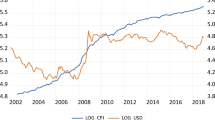Abstract
It has been widely documented that the exchange rate pass-through to domestic inflation has decreased significantly in most of the industrialized world. As microeconomic factors cannot completely explain such a widespread phenomenon, a macroeconomic explanation linked to the inflationary environment—that a low and more stable inflation rate leads to a decrease in the pass-through—has gained popularity. Using a structural VAR framework, this paper presents evidence of a similar decline in the pass-through in Peru, a small open economy that gradually reduced inflation to international levels in order to adopt a fully fledged inflation targeting scheme in 2002. It is argued that the establishment of a credible regime of low inflation has been instrumental in driving the exchange rate pass-through down.



Similar content being viewed by others
Notes
This channel is stronger if prices of some non-tradable goods or services, for instance rent, are set in dollars. In the Peruvian case, about 20 % of items in Lima CPI (the inflation indicator the central bank targets) are either imported or priced in dollars.
For previous studies on the exchange rate pass-through in Peru, see Winkelried (2003) and the references therein.
It is worth mentioning that a rather popular tool to analyze pass-through effects is the error correction model (ECM), which is just a VAR model in differences (e.g., inflation rates) augmented by a term to preserve cointegration among the levels (e.g., price indices). However, as stressed by Hendry (2006), inferences based on the ECM’s forecast function (tightly related to the IRF) can be seriously distorted due to deterministic breaks in the underlying cointegrating relationships. In view of this, we follow Hendry’s recommendation of ignoring the error-correcting terms and work with a VAR in differences. This approach should render more robust inferences when the data is suspected to be subject to deterministic breaks (either temporary or permanent).
In fact, the less striking differences in the pass-through on impact \((h=0)\) with respect to its long-run counterpart \((h \rightarrow \infty )\) reported in Fig. 2, suggest that it is the inherent dynamics of the VAR model what is important for the long-run results, rather than the size of the initial shock.
It is worth mentioning that a full set of estimations which use growth rates instead of cycle are considered in the working paper version of this article (Winkelried 2011).
References
Adolfson M (2007) Incomplete exchange rate pass-through and simple monetary policy rules. J Int Money Finance 26(3):468–494
Bai J, Lumsdaine RL, Stock JH (1998) Testing for and dating common breaks in multivariate time series. Rev Econ Stud 65(3):395–432
Campa J, Goldberg L (2005) Exchange rate pass-through into imports prices. Rev Econ Stat 87(4):679–690
Choudhri EU, Hakura DS (2006) Exchange rate pass-through to domestic prices: does the inflationary environment matter? J Int Money Finance 25(4):614–639
Clark TE (1999) The responses of prices at different stages of production to monetary policy shocks. Rev Econ Stat 81(3):420–433
Flamini A (2007) Inflation targeting and exchange rate pass-through. J Int Money Finance 26(7):1113–1150
Franses PH, Lucas A (1998) Outlier detection in cointegration analysis. J Bus Econ Stat 12:471–478
Goldberg PK, Knetter MM (1997) Goods prices and exchange rates: what have we learned? J Econ Lit 35(3):1243–1272
Hendry DF (2006) Robustifying forecasts from equilibrium-correction systems. J Econom 135(1–2): 399–426
Kaiser R, Maravall A (1999) Estimation of the business cycle: a modified Hodrick–Prescott filter. Span Econ Rev 1(2):175–206
Marazzi M, Sheets N (2007) Declining exchange rate pass-through to U.S. import prices: the potential role of global factors. J Int Money Finance 26(6):924–947
McCarthy J (2007) Pass-through of exchange rates and import prices to domestic inflation in some industrialized economies. East Econ J 33(4):511–537
Mihaljek D, Klau M (2008) Exchange rate pass-through in emerging market economies: what has changed and why? In: Bank for International Settlements (ed) Transmission mechanisms for monetary policy in emerging market economies, vol 35. Bank for International Settlements, Basel, pp 103–130
Pesaran HM, Shin Y (1998) Generalized impulse response analysis in linear multivariate models. Econ Lett 58(1):17–29
Rossini R, Vega M (2008) The monetary policy transmission mechanism under financial dollarisation: the case of Peru 1996–2006. In: Bank for International Settlements (ed) Transmission mechanisms for monetary policy in emerging market economies, vol 35. Bank for International Settlements, Basel, pp 395–412
Takhtamanova YF (2010) Understanding changes in exchange rate pass-through. J Macroecon 32(4): 1118–1130
Taylor JB (2000) Low inflation, pass-through, and the pricing power of firms. Eur Econ Rev 44(7): 1389–1408
Vega M, Winkelried D (2005) Inflation targeting and inflation behavior: a succesful story? Int J Central Banking 1(3):153–175
Winkelried D (2003) ¿Es asimétrico el pass-through en el Perú?: Un análisis agregado. Central Reserve Bank of Peru. Revista Estudios Económicos issue 10
Winkelried D (2011) Exchange rate pass-through and inflation targeting in Peru. Central Reserve Bank of Peru, Working paper 2011–12
Acknowledgments
I would like to thank Adrián Armas and seminar participants at the Central Reserve Bank of Peru for helpful comments. I am also grateful to an anonymous referee for very useful suggestions. The usual disclaimer applies.
Author information
Authors and Affiliations
Corresponding author
Data appendix
Data appendix
Table 1 describes the data. For each variable in the VAR the first definition is used in the base model of Sect. 3.2, whereas the others feature the robustness checks of Sect. 3.3. Most of the series are available online at the BCRP’s website (http://www.bcrp.gob.pe/statistics.html) and are regularly published in its Weekly Report (Nota Semanal). When applicable, the column “Source” in Table 1 shows the page number of the Weekly Report where each series can be found. The data on wholesale price indices used to measure importer and producer prices come from the National Statistical Office (INEI) and are also available online (http://iinei.inei.gob.pe/iinei/siemweb/publico).
Rights and permissions
About this article
Cite this article
Winkelried, D. Exchange rate pass-through and inflation targeting in Peru. Empir Econ 46, 1181–1196 (2014). https://doi.org/10.1007/s00181-013-0715-4
Received:
Accepted:
Published:
Issue Date:
DOI: https://doi.org/10.1007/s00181-013-0715-4




